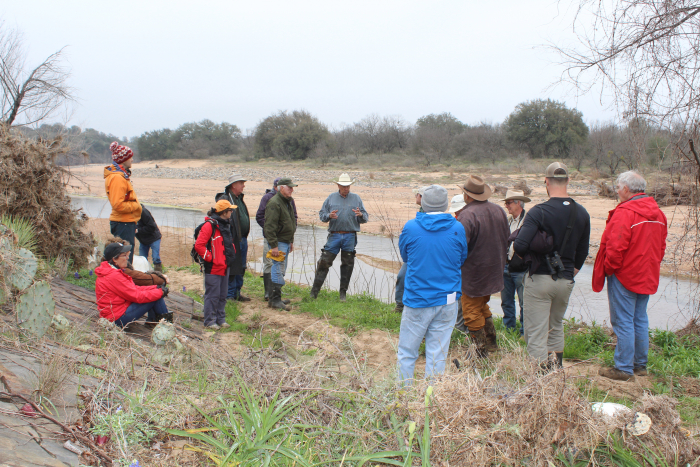Landowners work to “heal” Sandy Creek after flood

Connie Swinney/The Highlander
Hill Country Alliance, Save Sandy Creek members and several other volunteers planted grasses, sedges and trees March 2 along Sandy Creek, just off Texas 71 to mitigate future flood issues.
By Connie Swinney
Staff Writer
An effort to restore Sandy Creek has taken root in Llano County.
About 25 landowners, conservationists and other volunteers attended the Sandy Creek Riparian Restoration Field Day March 2 on private property (County Road 316) adjacent to Sandy Creek to assess land and put so-called revegetation efforts into practice.
“People like myself and other professionals, we really didn't think about rivers. They were just part of the landscape,” said Steve Nelle, a Natural Resource Conservation Service retiree. “We didn't know anything about how to manage them or take care of them.”
Sponsored by Hill Country Alliance, the Bender family welcomed the volunteers to their property to tour the creek shoreline, plant black willow cuttings and sedges as well as broadcast native seed and transplant muhly grasses.
To the master gardener or ecologist, the terms and protocol have become second nature.
The focus on field day involved motivating landowners to adopt the same practices on private property.
“We have brought together landowners from Sandy Creek and adjacent creeks and rivers who care about the health of these waterways,” Hill Country Alliance Land Program Manager Daniel Oppenheimer said. “If we don't have healthy riparian areas, along our creeks and rivers, we're going to have less water.
“It's going to be poorer quality water and we're not going to be able to mitigate our floods as well.”
Experts have assessed the impact of the most recent flood event in October 2018 and discovered how lack of vegetation may have made the outcome worse.
“With the last flood event, we saw an incredible amount of scour that occurred and a loss of vegetation and in some areas the deposition of sediment,” said Conservation Ecologist Ryan McGillicuddy of Texas Parks and Wildlife.
“Voluntary stream side management” can restore and revitalize the function and beauty of waterways, he explained.
“Managing your stream side area in a way that encourages the establishment of native vegetation is being a good steward,” he said. “We certainly could see more of it across the state and across the country.”
He continued that much of stream side management involves removing the “source of the disturbance – which includes excessive grazing, vehicle or foot traffic – and allowing nature to take the process of restoring itself.”
“We encourage landowners to let vegetation do the job of assimilating that new material and stabilizing those banks.”
A critical aspect of restoration includes cultivating the shoreline foliage to catch sand and direct the flow into a route conducive to restoring the health of the waterway.
“Whenever you have this kind of flood, you need all of this recurring vegetation to slow down the sand,” said Save Sandy Creek Chairman Fermin Ortiz, who volunteered during the field day. “You can't stop the sand, but you can capture some of it, so not all of it is traveling all the way down to the mouth.”
Volunteer and Mason County landowner Frank Brown added, “We want to prevent further erosion and improve the habitat.”
To find out more, visit HillCountryAlliance.org and SaveSandyCreek.org.






